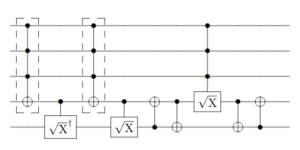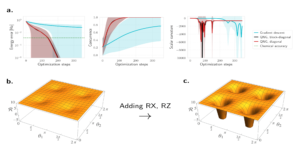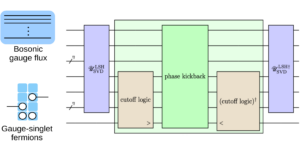
Center for Theoretical Physics, Polish Academy of Sciences, Aleja Lotników 32/46, 02-668 Warsaw, Poland
Find this paper interesting or want to discuss? Scite or leave a comment on SciRate.
Abstract
Genuinely entangled subspaces are a class of subspaces in the multipartite Hilbert spaces that are composed of only genuinely entangled states. They are thus an interesting object of study in the context of multipartite entanglement. Here we provide a construction of multipartite subspaces that are not only genuinely entangled but also fully non-positive-partial-transpose (NPT) in the sense that any mixed state supported on them has non-positive partial transpose across any bipartition. Our construction originates from the stabilizer formalism known for its use in quantum error correction. To this end, we first introduce a couple of criteria allowing to assess whether any state from a given non-trivial stabilizer subspace is genuinely multipartite entangled. We then use these criteria to construct genuinely entangled stabilizer subspaces for any number of parties and arbitrary local dimension and conjecture them to be of maximal dimension achievable within the stabilizer formalism. At the same time, we prove that every genuinely entangled subspace is fully NPT in the above sense, which implies a quite surprising fact that no genuinely entangled stabilizer subspace can support PPT entangled states.
► BibTeX data
► References
[1] 4 R. Horodecki, P. Horodecki, M. Horodecki, and K. Horodecki, “Quantum entanglement,” Rev. Mod. Phys., vol. 81, pp. 865–942, Jun 2009. [Online]. Available: https://doi.org/10.1103/RevModPhys.81.865 0pt.
https://doi.org/10.1103/RevModPhys.81.865
[2] 4 C. H. Bennett, G. Brassard, C. Crépeau, R. Jozsa, A. Peres, and W. K. Wootters, “Teleporting an unknown quantum state via dual classical and einstein-podolsky-rosen channels,” Phys. Rev. Lett., vol. 70, pp. 1895–1899, Mar 1993. [Online]. Available: https://doi.org/10.1103/PhysRevLett.70.1895 0pt.
https://doi.org/10.1103/PhysRevLett.70.1895
[3] 4 A. K. Ekert, “Quantum cryptography based on bell’s theorem,” Phys. Rev. Lett., vol. 67, pp. 661–663, Aug 1991. [Online]. Available: https://doi.org/10.1103/PhysRevLett.67.661 0pt.
https://doi.org/10.1103/PhysRevLett.67.661
[4] 4 H. M. Wiseman, S. J. Jones, and A. C. Doherty, “Steering, entanglement, nonlocality, and the einstein-podolsky-rosen paradox,” Phys. Rev. Lett., vol. 98, p. 140402, Apr 2007. [Online]. Available: https://doi.org/10.1103/PhysRevLett.98.140402 0pt.
https://doi.org/10.1103/PhysRevLett.98.140402
[5] 4 J. S. Bell, “On the einstein podolsky rosen paradox,” Physics Physique Fizika, vol. 1, pp. 195–200, Nov 1964. [Online]. Available: https://doi.org/10.1103/PhysicsPhysiqueFizika.1.195 0pt.
https://doi.org/10.1103/PhysicsPhysiqueFizika.1.195
[6] 4 D. Cavalcanti and P. Skrzypczyk, “Quantum steering: a review with focus on semidefinite programming,” Reports on Progress in Physics, vol. 80, no. 2, p. 024001, dec 2016. [Online]. Available: https://doi.org/10.1088/1361-6633/80/2/024001 0pt.
https://doi.org/10.1088/1361-6633/80/2/024001
[7] 4 N. Brunner, D. Cavalcanti, S. Pironio, V. Scarani, and S. Wehner, “Bell nonlocality,” Rev. Mod. Phys., vol. 86, pp. 419–478, Apr 2014. [Online]. Available: https://doi.org/10.1103/RevModPhys.86.419 0pt.
https://doi.org/10.1103/RevModPhys.86.419
[8] 4 A. Acín, N. Brunner, N. Gisin, S. Massar, S. Pironio, and V. Scarani, “Device-independent security of quantum cryptography against collective attacks,” Phys. Rev. Lett., vol. 98, p. 230501, Jun 2007. [Online]. Available: https://doi.org/10.1103/PhysRevLett.98.230501 0pt.
https://doi.org/10.1103/PhysRevLett.98.230501
[9] 4 O. Gühne and G. Tóth, “Entanglement detection,” Physics Reports, vol. 474, no. 1, pp. 1–75, 2009. [Online]. Available: https://doi.org/10.1016/j.physrep.2009.02.004 0pt.
https://doi.org/10.1016/j.physrep.2009.02.004
[10] 4 L. Gurvits, “Classical complexity and quantum entanglement,” Journal of Computer and System Sciences, vol. 69, no. 3, pp. 448–484, 2004, special Issue on STOC 2003. [Online]. Available: https://doi.org/10.1016/j.jcss.2004.06.003 0pt.
https://doi.org/10.1016/j.jcss.2004.06.003
[11] 4 R. Schmied, J.-D. Bancal, B. Allard, M. Fadel, V. Scarani, P. Treutlein, and N. Sangouard, “Bell correlations in a bose-einstein condensate,” Science, vol. 352, no. 6284, pp. 441–444, 2016. [Online]. Available: https://doi.org/10.1126/science.aad8665 0pt.
https://doi.org/10.1126/science.aad8665
[12] 4 N. J. Engelsen, R. Krishnakumar, O. Hosten, and M. A. Kasevich, “Bell correlations in spin-squeezed states of 500 000 atoms,” Phys. Rev. Lett., vol. 118, p. 140401, Apr 2017. [Online]. Available: https://doi.org/10.1103/PhysRevLett.118.140401 0pt.
https://doi.org/10.1103/PhysRevLett.118.140401
[13] 4 F. Fröwis, P. Strassmann, and A. e. a. Tiranov, “Experimental certification of millions of genuinely entangled atoms in a solid,” Nature Communication, vol. 8, p. 907, 2017. [Online]. Available: https://doi.org/10.1038/s41467-017-00898-6 0pt.
https://doi.org/10.1038/s41467-017-00898-6
[14] 4 K. Giovanetti, S. Lloyd, and L. Maccone, “Advances in quantum metrology,” Nature Photon., vol. 5, pp. 222–229, March 2011. [Online]. Available: https://doi.org/10.1038/nphoton.2011.35 0pt.
https://doi.org/10.1038/nphoton.2011.35
[15] 4 R. Raussendorf and H. J. Briegel, “A one-way quantum computer,” Phys. Rev. Lett., vol. 86, pp. 5188–5191, May 2001. [Online]. Available: https://doi.org/10.1103/PhysRevLett.86.5188 0pt.
https://doi.org/10.1103/PhysRevLett.86.5188
[16] 4 L. Amico, R. Fazio, A. Osterloh, and V. Vedral, “Entanglement in many-body systems,” Rev. Mod. Phys., vol. 80, pp. 517–576, May 2008. [Online]. Available: https://doi.org/10.1103/RevModPhys.80.517 0pt.
https://doi.org/10.1103/RevModPhys.80.517
[17] 4 O. Gühne and M. Seevinck, “Separability criteria for genuine multiparticle entanglement,” New Journal of Physics, vol. 12, no. 5, p. 053002, may 2010. [Online]. Available: https://doi.org/10.1088/1367-2630/12/5/053002 0pt.
https://doi.org/10.1088/1367-2630/12/5/053002
[18] 4 B. Jungnitsch, T. Moroder, and O. Gühne, “Taming multiparticle entanglement,” Phys. Rev. Lett., vol. 106, p. 190502, May 2011. [Online]. Available: https://doi.org/10.1103/PhysRevLett.106.190502 0pt.
https://doi.org/10.1103/PhysRevLett.106.190502
[19] 4 M. Huber, P. Erker, H. Schimpf, A. Gabriel, and B. Hiesmayr, “Experimentally feasible set of criteria detecting genuine multipartite entanglement in $n$-qubit dicke states and in higher-dimensional systems,” Phys. Rev. A, vol. 83, p. 040301, Apr 2011. [Online]. Available: https://doi.org/10.1103/PhysRevA.83.040301 0pt.
https://doi.org/10.1103/PhysRevA.83.040301
[20] 4 M. Paraschiv, N. Miklin, T. Moroder, and O. Gühne, “Proving genuine multiparticle entanglement from separable nearest-neighbor marginals,” Phys. Rev. A, vol. 98, p. 062102, Dec 2018. [Online]. Available: https://doi.org/10.1103/PhysRevA.98.062102 0pt.
https://doi.org/10.1103/PhysRevA.98.062102
[21] 4 M. Mičuda, R. Stárek, J. Provazník, O. Leskovjanová, and L. Mišta, “Verifying genuine multipartite entanglement of the whole from its separable parts,” Optica, vol. 6, no. 7, pp. 896–901, Jul 2019. [Online]. Available: https://doi.org/10.1364/OPTICA.6.000896 0pt.
https://doi.org/10.1364/OPTICA.6.000896
[22] 4 C. Eltschka and J. Siewert, “Maximum $N$-body correlations do not in general imply genuine multipartite entanglement,” Quantum, vol. 4, p. 229, Feb. 2020. [Online]. Available: https://doi.org/10.22331/q-2020-02-10-229 0pt.
https://doi.org/10.22331/q-2020-02-10-229
[23] 4 S. A. Rather, A. Burchardt, W. Bruzda, G. Rajchel-Mieldzioć, A. Lakshminarayan, and K. Życzkowski, “Thirty-six entangled officers of euler: Quantum solution to a classically impossible problem,” Phys. Rev. Lett., vol. 128, p. 080507, Feb 2022. [Online]. Available: https://doi.org/10.1103/PhysRevLett.128.080507 0pt.
https://doi.org/10.1103/PhysRevLett.128.080507
[24] 4 M. Demianowicz and R. Augusiak, “From unextendible product bases to genuinely entangled subspaces,” Phys. Rev. A, vol. 98, p. 012313, 2018. [Online]. Available: https://doi.org/10.1103/PhysRevA.98.012313 0pt.
https://doi.org/10.1103/PhysRevA.98.012313
[25] 4 ——, “An approach to constructing genuinely entangled subspaces of maximal dimension,” Quantum Information Processing, vol. 19, no. 7, 2020. [Online]. Available: http://dx.doi.org/10.1007/s11128-020-02688-4 0pt.
https://doi.org/10.1007/s11128-020-02688-4
[26] 4 S. Agrawal, S. Halder, and M. Banik, “Genuinely entangled subspace with all-encompassing distillable entanglement across every bipartition,” Phys. Rev. A, vol. 99, p. 032335, 2019. [Online]. Available: https://doi.org/10.1103/PhysRevA.99.032335 0pt.
https://doi.org/10.1103/PhysRevA.99.032335
[27] 4 M. Demianowicz, G. Rajchel-Mieldzioć, and R. Augusiak, “Simple sufficient condition for subspace to be completely or genuinely entangled,” New Journal of Physics, vol. 23, no. 10, p. 103016, 2021. [Online]. Available: https://doi.org/10.1088/1367-2630/ac2a5c 0pt.
https://doi.org/10.1088/1367-2630/ac2a5c
[28] 4 M. Demianowicz, “Universal construction of genuinely entangled subspaces of any size,” Quantum, vol. 6, p. 854, nov 2022. [Online]. Available: https://doi.org/10.22331/q-2022-11-10-854 0pt.
https://doi.org/10.22331/q-2022-11-10-854
[29] 4 K. V. Antipin, “Construction of genuinely entangled subspaces and the associated bounds on entanglement measures for mixed states,” Journal of Physics A: Mathematical and Theoretical, vol. 54, no. 50, p. 505303, 2021. [Online]. Available: https://doi.org/10.1088/1751-8121/ac37e5 0pt.
https://doi.org/10.1088/1751-8121/ac37e5
[30] D. E. Gottesman, “Stabilizer codes and quantum error correction,” Ph.D. dissertation, California Institute of Technology, 1997.
[31] 4 A. M. Steane, “Error correcting codes in quantum theory,” Phys. Rev. Lett., vol. 77, pp. 793–797, Jul 1996. [Online]. Available: https://doi.org/10.1103/PhysRevLett.77.793 0pt.
https://doi.org/10.1103/PhysRevLett.77.793
[32] 4 A. Kitaev, “Fault-tolerant quantum computation by anyons,” Annals of Physics, vol. 303, no. 1, pp. 2–30, 2003. [Online]. Available: https://doi.org/10.1016/S0003-4916(02)00018-0 0pt.
https://doi.org/10.1016/S0003-4916(02)00018-0
[33] 4 P. J. Nadkarni and S. S. Garani, “Quantum error correction architecture for qudit stabilizer codes,” Phys. Rev. A, vol. 103, p. 042420, Apr 2021. [Online]. Available: https://doi.org/10.1103/PhysRevA.103.042420 0pt.
https://doi.org/10.1103/PhysRevA.103.042420
[34] 4 F. Huber and M. Grassl, “Quantum Codes of Maximal Distance and Highly Entangled Subspaces,” Quantum, vol. 4, p. 284, Jun. 2020. [Online]. Available: https://doi.org/10.22331/q-2020-06-18-284 0pt.
https://doi.org/10.22331/q-2020-06-18-284
[35] 4 O. Makuta and R. Augusiak, “Self-testing maximally-dimensional genuinely entangled subspaces within the stabilizer formalism,” New Journal of Physics, vol. 23, no. 4, p. 043042, 2021. [Online]. Available: https://doi.org/10.1088/1367-2630/abee40 0pt.
https://doi.org/10.1088/1367-2630/abee40
[36] 4 N. Johnston, “Non-positive-partial-transpose subspaces can be as large as any entangled subspace,” Phys. Rev. A, vol. 87, p. 064302, 2013. [Online]. Available: https://doi.org/10.1103/PhysRevA.87.064302 0pt.
https://doi.org/10.1103/PhysRevA.87.064302
[37] 4 E. Hostens, J. Dehaene, and B. De Moor, “Stabilizer states and clifford operations for systems of arbitrary dimensions and modular arithmetic,” Phys. Rev. A, vol. 71, p. 042315, Apr 2005. [Online]. Available: https://doi.org/10.1103/PhysRevA.71.042315 0pt.
https://doi.org/10.1103/PhysRevA.71.042315
[38] 4 V. Gheorghiu, “Standard form of qudit stabilizer groups,” Physics Letters A, vol. 378, no. 5, pp. 505–509, 2014. [Online]. Available: https://www.doi.org/10.1016/j.physleta.2013.12.009 0pt.
https://doi.org/10.1016/j.physleta.2013.12.009
[39] M. A. Nielsen and I. L. Chuang, Quantum Computation and Quantum Information. Cambridge University Press, 2000.
[40] 4 R. F. Werner and M. M. Wolf, “Bell’s inequalities for states with positive partial transpose,” Phys. Rev. A, vol. 61, p. 062102, May 2000. [Online]. Available: https://doi.org/10.1103/PhysRevA.61.062102 0pt.
https://doi.org/10.1103/PhysRevA.61.062102
[41] 4 A. Peres, “Separability criterion for density matrices,” Phys. Rev. Lett., vol. 77, pp. 1413–1415, 1996. [Online]. Available: https://doi.org/10.1103/PhysRevLett.77.1413 0pt.
https://doi.org/10.1103/PhysRevLett.77.1413
[42] 4 F. Baccari, R. Augusiak, I. Šupić, and A. Acín, “Device-independent certification of genuinely entangled subspaces,” Phys. Rev. Lett., vol. 125, p. 260507, 2020. [Online]. Available: https://doi.org/10.1103/PhysRevLett.125.260507 0pt.
https://doi.org/10.1103/PhysRevLett.125.260507
Cited by
[1] Fabian Bernards and Otfried Gühne, “Multiparticle singlet states cannot be maximally entangled for the bipartitions”, arXiv:2211.03813, (2022).
[2] K. V. Antipin, “On generating r-uniform subspaces with the isometric mapping method”, arXiv:2301.03120, (2023).
[3] Maciej Demianowicz, “Universal construction of genuinely entangled subspaces of any size”, Quantum 6, 854 (2022).
The above citations are from SAO/NASA ADS (last updated successfully 2023-02-12 13:16:50). The list may be incomplete as not all publishers provide suitable and complete citation data.
On Crossref’s cited-by service no data on citing works was found (last attempt 2023-02-12 13:03:08).
This Paper is published in Quantum under the Creative Commons Attribution 4.0 International (CC BY 4.0) license. Copyright remains with the original copyright holders such as the authors or their institutions.
- SEO Powered Content & PR Distribution. Get Amplified Today.
- Platoblockchain. Web3 Metaverse Intelligence. Knowledge Amplified. Access Here.
- Source: https://quantum-journal.org/papers/q-2023-02-09-915/
- 000
- 1
- 10
- 11
- 1996
- 2001
- 2011
- 2014
- 2016
- 2017
- 2018
- 2019
- 2020
- 2021
- 2022
- 2023
- 28
- 39
- 67
- 7
- 70
- 77
- 9
- 98
- a
- above
- ABSTRACT
- Academy
- access
- across
- affiliations
- against
- All
- Allowing
- and
- approach
- architecture
- associated
- Attacks
- Aug
- author
- authors
- available
- based
- Bell
- Break
- california
- cambridge
- cannot
- Certification
- channels
- class
- Collective
- comment
- Commons
- Communication
- complete
- completely
- complexity
- composed
- computation
- computer
- condition
- conjecture
- construct
- constructing
- construction
- context
- copyright
- Couple
- criteria
- cryptography
- data
- Detection
- Dimension
- dimensions
- discuss
- distance
- error
- Every
- feasible
- First
- Focus
- form
- found
- from
- fully
- General
- generating
- given
- Group’s
- harvard
- here
- highly
- holders
- HTTPS
- impossible
- in
- inequalities
- information
- Institute
- institutions
- interesting
- International
- introduce
- issue
- JavaScript
- journal
- known
- large
- Last
- Leave
- License
- List
- local
- mapping
- March
- mathematical
- measures
- method
- Metrology
- millions
- mixed
- modular
- Month
- Nature
- New
- number
- object
- officers
- online
- open
- Operations
- original
- Paper
- Paradox
- parties
- parts
- Physics
- plato
- Plato Data Intelligence
- PlatoData
- Polish
- positive
- press
- Problem
- processing
- Product
- Programming
- Progress
- Prove
- provide
- published
- publisher
- publishers
- Quantum
- Quantum Computer
- quantum cryptography
- quantum entanglement
- quantum error correction
- quantum information
- references
- remains
- Reports
- review
- same
- Science
- SCIENCES
- security
- sense
- set
- Size
- solid
- solution
- spaces
- special
- State
- States
- Study
- Successfully
- such
- sufficient
- suitable
- support
- Supported
- surprising
- system
- Systems
- Technology
- The
- their
- theoretical
- time
- Title
- to
- under
- Universal
- university
- updated
- URL
- use
- via
- volume
- W
- Warsaw
- whether
- which
- whole
- within
- Wolf
- works
- year
- zephyrnet












